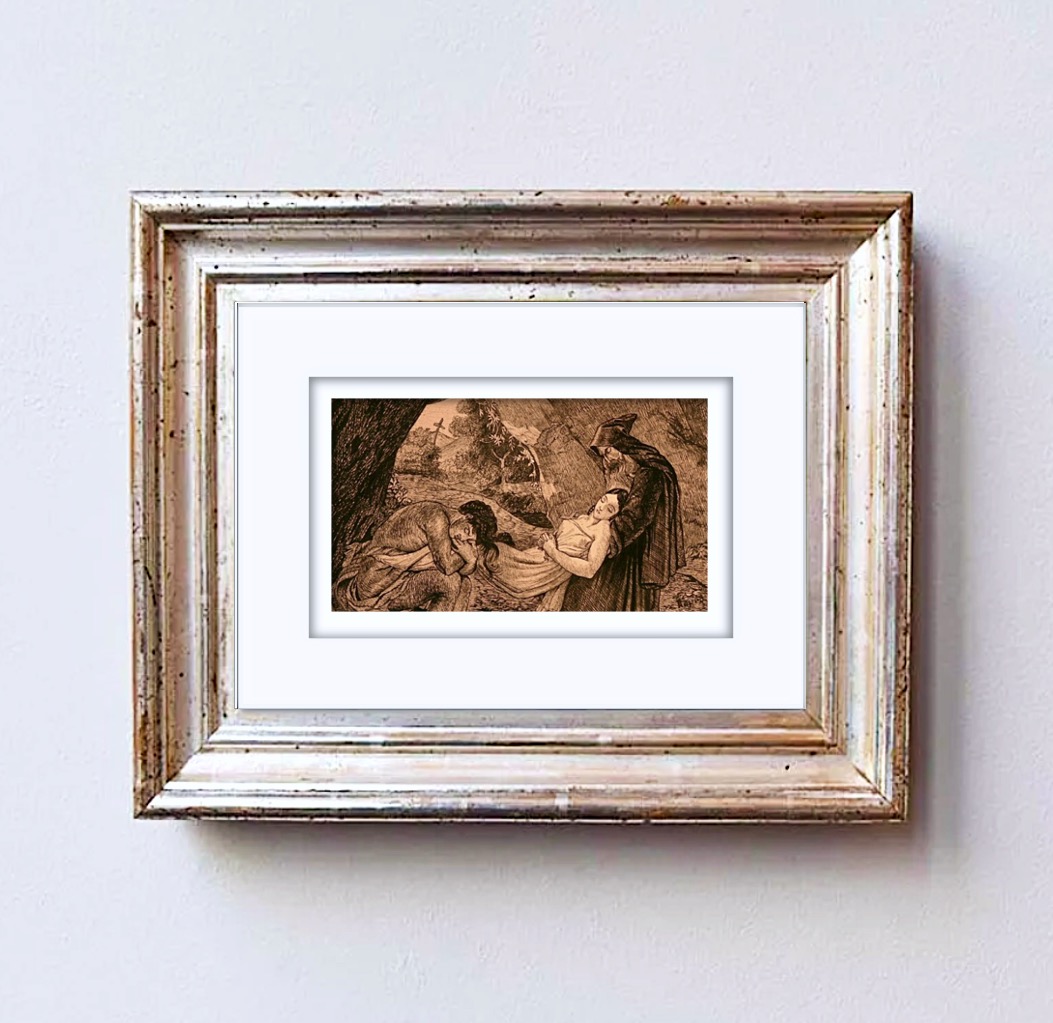

Title: Pen and Ink Drawing Love Death Atala By Anne Louis Girodet Trioson
Shipping: $9.00
Artist: N/A
Period: 19th Century
History: N/A
Origin: Central Europe > France
Condition: Excellent
Item Date: 1800 to 1900
Item ID: 2476
Original work on paper pen and ink drawing. This vivacious drawing is a preparatory study for one of Anne Louis Girodet Trioson, most celebrated paintings. It is based on Chateaubriand's romantic novel, Atala, ou Les amours de deux sauvages dans le désert, the story of an ill-fated love. Emerging from the scribble of exploratory lines, Atala is seen on her deathbed in the grotto of the missionary Father Aubry, while her lover Chactas, will not let her go. Atala's funeral, an illustration of Rene de Chateaubriand's novel "Atala",1808 Love & Death: Atala au tombeau,1808,Girodet de Roussy -Trioson, Louvre. 1808 ink drawing and pencil sketch. Sign by the artist Anne-Louis Girodet-Trioson) January 5, 1767 December 9, 1824) For the painting The Entombment of Atala Oil on canvas. Atala au tombeau,1808. was a French painter and pupil of Jacques-Louis David, who was part of the beginning of the Romantic movement by adding elements of eroticism through his paintings. Girodet is remembered for his precise and clear style and for his paintings of members of the Napoleonic family. This is a cool little antique pen and ink drawing of love and death. This is tatty round the edges but generally considering how old it is in good condition. An old artist sketch series, on old original paper with it's beautifully ink drawing. There have been countless exhibitions that have presented the works of other great European artists, While most sketches have long ago entered public collections, these drawings are actively sought today by collectors both public and private when seen on today's market. This sketch is Unframed! (Atala au tombeau) Atala falls in love with Chactas, but cannot marry him as she has taken a vow of chastity. In despair she takes poison. Aubry assumes that she is merely ill, but in the presence of Chactas she reveals what she has done, and Chactas is filled with anger until the missionary tells them that in fact Christianity permits the renunciation of vows. They tend her, but she dies, and the day after the funeral, Chactas takes Aubry's advice and leaves the mission. Atala is an early novella by François-René de Chateaubriand, first published on 12 germinal IX (2 April 1801). The work, inspired by his travels in North America, had an immense impact on early Romanticism, and went through five editions in its first year. It was adapted frequently for stage, and translated into many languages. * Atala's illuminated lifeless form has a luminous clarity of innocence and serenity against the backdrop of death's presence; as if her life has never made so much sense as in this moment just before entombment away from the living, as if the tenderness of the painter's moving brush has perfectly captured, with instinctive comprehension, a multitude of emotions impossible to put into words.
Link: http://en.wikipedia.org/wiki/Anne-Louis_Girodet_de_Roussy-Trioson
Girodet was born at Montargis. He lost his parents in early youth and the care of his inheritance and education fell to his guardian, M. Trioson, "medecin-de-mesdames," by whom he was in later life adopted and whose surname he took in 1812. He started in school by studying architecture and pursuing a military career. He later changed to the study of painting under a painter named Luquin, before entering the school of David. From 1789 to 1793 he lived in Italy where, at the age of twenty-two, he successfully competed for the Prix de Rome thus making a name for himself for his painting of the Story of Joseph and his Brethren. At Rome he painted his Hippocrate refusant les presents d'Artaxerxes and Endymion-dormant (presently held in the Louvre), work which was praised at the Salon of 1793.
Back in France, Girodet painted many portraits, including some of the members of the Napoléon family. In 1806, he exhibited "Scène de déluge" (Louvre), to which (in competition with the "Sabines" of David) was awarded the decennial prize. This success was followed up in 1808 by the production of the "Reddition de Vienne" and "Atala au Tombeau" a work which went far to deserve its immense popularity, by a happy choice of subject, and remarkable freedom from the theatricality of Girodet's usual manner, which, however, soon returned again in his "La Révolte du Caire" (1810). Girodet was a member of the Academy of Painting and of the Institute of France; a knight of the order of St. Michael, and officer of the Legion of Honour.